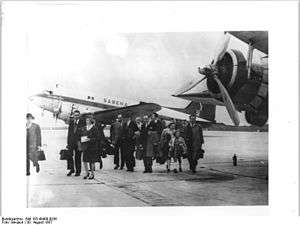1948 Heathrow Disaster
|
A Sabena DC-3, similar to the accident aircraft | |
| Accident summary | |
|---|---|
| Date | 2 March 1948 |
| Summary | Mechanical failure combined with poor weather conditions and pilot error |
| Site | Heathrow Airport |
| Passengers | 19 |
| Crew | 3 |
| Injuries (non-fatal) | 2 |
| Fatalities | 20 |
| Survivors | 2 (3 initially) |
| Aircraft type | Douglas DC-3C |
| Operator | Sabena |
| Registration | OO-AWH |
| Flight origin | Brussel-Zaventem airport (BRU/EBBR), Belgium |
| Destination | London Airport (LHR/EGLL), United Kingdom |
The 1948 Heathrow Disaster was the crash of a Douglas DC-3C of the Belgian airline Sabena at Heathrow Airport, London, United Kingdom on 2 March 1948. It was the first major accident at Heathrow Airport; of the 22 people on board 20 were killed, of whom most had British nationality.[1]
Aircraft
The DC-3 involved was built in 1947 with serial number 43154 and registration OO-AWH and was used by the Belgian airline company Sabena from 21 March 1947 until its destruction in 1948. It was built for a US military contract but was never delivered and was the last DC-3 to be built by Douglas.[2]
Crash
The Sabena flight was a Douglas DC-3 which departed from Brussels, Belgium on route to London, United Kingdom under the command of pilot Henri Goblet and radio officer Jean Lomba.
| Nationality | Passengers | Crew | Total | |||
|---|---|---|---|---|---|---|
| Total | Killed | Total | Killed | Total | Killed | |
| 0 | 0 | 3 | 3 | 3 | 3 | |
| 13 | 12 | 0 | 0 | 13 | 12 | |
| 2 | 1 | 0 | 0 | 2 | 1 | |
| 1 | 1 | 0 | 0 | 1 | 1 | |
| 1 | 1 | 0 | 0 | 1 | 1 | |
| 1 | 1 | 0 | 0 | 1 | 1 | |
| 1 | 1 | 0 | 0 | 1 | 1 | |
| Total | 19 | 17 | 3 | 3 | 22 | 20 |
On approach to Heathrow at 9:15 PM, captain Goblet made a radio call to air traffic control telling them that the aircraft had suffered a mechanical malfunction and that he had to make an emergency landing at the airport. The captain received clearance to land on the main runway, but the weather deteriorated and a thick fog appeared on the airport which reduced visibility. Moments later the radio signal was lost and a massive explosion was heard on the ground.[4]
Workers in a hangar nearby saw the aircraft crash on the runway and quickly went to the survivors aid. When they reached the aircraft there was utter devastation, only the tail section of the aircraft was left intact. However, there were survivors and the workers quickly pulled a few passengers from the burning wreckage. They could hear the screams of those still trapped in the inferno and despite all their efforts those people perished. When emergency personnel finally arrived on the scene, there was no one left to save. It was later concluded that a high number of passengers survived the crash but died in the blaze either by burning to death or smoke inhalation. The three survivors were badly burned and were quickly taken to the hospital were one of them died from his injuries. The two survivors were former MP Otho Nicholson and a Polish man named Jan Oles.[5]
Investigation
The final conclusion of the investigation was that there were two technical malfunctions which resulted in a short circuit. The short circuit could have started an on-board fire which resulted in the pilot's decision to make an emergency landing. Some eyewitnesses claimed to have seen the aircraft on fire before the crash which supports this theory. The decision of the pilot to land at night and in thick fog was dangerous but he did not have a choice. The pilot misjudged the landing and the aircraft was torn apart and destroyed when it hit the ground and killed the crew as well as some passengers instantly. The few survivors were then trapped by the raging fire. Two of the three survivors were thrown out of the aircraft at the moment of impact and the third, who later died, was pulled out of the burning wreckage.[6]
References
- ↑ "Rampen in België". books.google.be. 2005. Retrieved 3 February 2016.
- ↑ "London air crash Dakota bursts into flames". thetimes.co.uk. 3 March 2003. Retrieved 3 February 2016.
- ↑ "OO-AWH". issuu.com. 2014. Retrieved 3 February 2016.
- ↑ "Accident". aviation-safety.net. 1996. Retrieved 3 February 2016.
- ↑ "19 killed in crash of Dakota". gov.au. 4 March 1948. Retrieved 3 February 2016.
- ↑ "Accident Details". planecrashinfo.com. Retrieved 3 February 2016.
| ||||||
